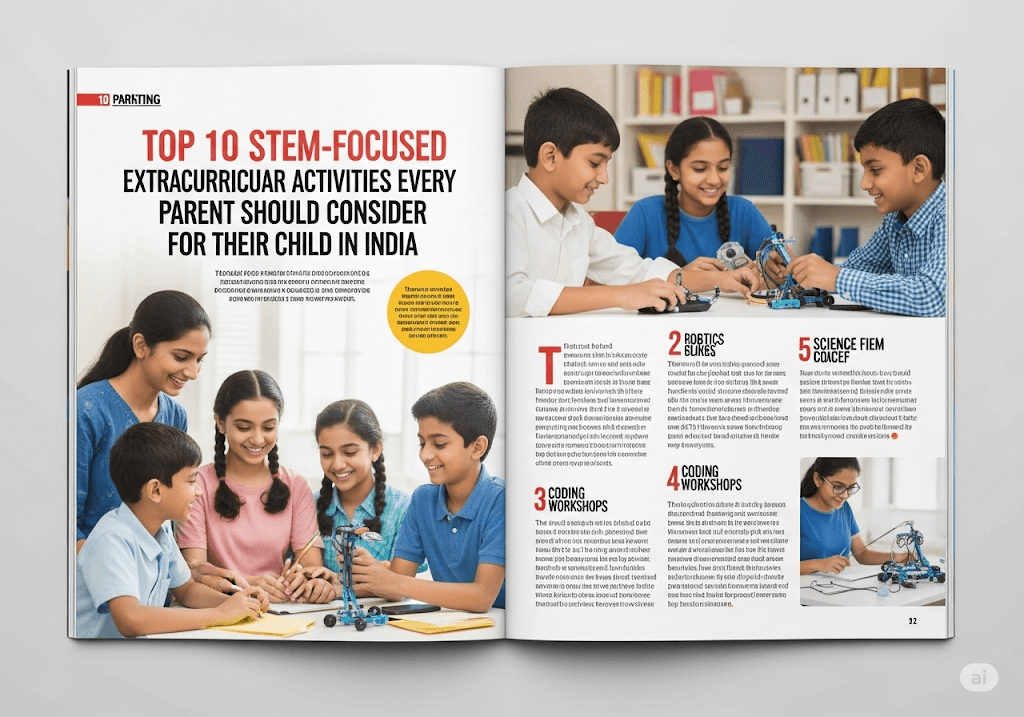Top 10 STEM-Focused Extracurricular Activities Every Parent Should Consider for Their Child in India
In today’s fast-evolving world, fostering a love for science, technology, engineering, and mathematics (STEM) is essential for children to thrive. Extracurricular activities for students in India provide exciting opportunities to spark curiosity, build skills, and prepare kids for future careers in STEM fields.
Whether your child is tinkering with gadgets or solving complex problems, STEM education in India is enriched through hands-on, engaging extracurricular activities for kids. Below, we explore the top 10 STEM-focused extracurricular activities that parents should consider to nurture their child’s potential.
What Are Extracurricular Activities?
Extracurricular activities are pursuits outside the standard academic curriculum that help children develop new skills, explore interests, and build confidence. In the context of STEM, these activities focus on practical, real-world applications of science, technology, engineering, and math, making learning fun and impactful.
1. Robotics Clubs
What It Is: Robotics clubs engage children in designing, building, and programming robots using kits like LEGO Mindstorms or Arduino.
Benefits:
Develops problem-solving and logical thinking.
Encourages teamwork and creativity.
Introduces coding and engineering concepts.
How to Get Involved: Look for local robotics clubs or workshops offered by organizations like Roboversity or STEM labs in cities like Bangalore, Delhi, and Mumbai. Online platforms also provide virtual robotics courses for kids aged 8–16.
2. Science Fairs and Competitions
What It Is: Science fairs allow kids to create and present projects on topics like renewable energy or biology experiments.
Benefits:
Enhances research and presentation skills.
Fosters scientific curiosity and critical thinking.
Builds confidence in public speaking.
How to Get Involved: Encourage participation in events like the National Science Fair or Google Science Fair. Schools and community centers often host local fairs for kids aged 10–18.
3. Coding Bootcamps
What It Is: Short, intensive programs teaching programming languages like Python, Scratch, or JavaScript.
Benefits:
Builds computational thinking and problem-solving.
Prepares kids for tech-driven careers.
Boosts creativity through app or game development.
How to Get Involved: Platforms like WhiteHat Jr. or Codeyoung offer online and offline coding classes across India. Look for age-appropriate programs for kids aged 6–18.
4. STEM Workshops
What It Is: Hands-on sessions focusing on topics like 3D printing, AI, or renewable energy, often hosted by STEM centers or museums.
Benefits:
Exposes kids to cutting-edge technologies.
Encourages experimentation and innovation.
Connects theoretical learning to real-world applications.
How to Get Involved: Check out workshops at science museums like the Nehru Science Centre in Mumbai or organizations like STEM Academy of India. Suitable for ages 8–16.
5. Math Olympiads
What It Is: Competitive math events where kids solve challenging problems to test their analytical skills.
Benefits:
Sharpens logical reasoning and problem-solving.
Builds resilience and perseverance.
Prepares kids for national and international competitions.
How to Get Involved: Enroll your child in programs like the Indian National Mathematical Olympiad (INMO) or regional math clubs. Ideal for students aged 10–18.
6. Astronomy Clubs
What It Is: Groups where kids explore celestial phenomena through stargazing, telescope building, or planetarium visits.
Benefits:
Ignites curiosity about space and physics.
Develops observational and analytical skills.
Encourages teamwork during group activities.
How to Get Involved: Join local astronomy clubs like the Amateur Astronomers Association or online programs by ISRO. Suitable for ages 8–18.
7. Maker Spaces and Tinkering Labs
What It Is: Creative spaces where kids build prototypes, experiment with electronics, or engage in DIY projects.
Benefits:
Promotes hands-on learning and innovation.
Enhances creativity and engineering skills.
Encourages collaboration and experimentation.
How to Get Involved: Visit maker spaces in cities like Hyderabad, Chennai, or Pune, or explore online tinkering resources. Great for kids aged 7–16.
8. Environmental Science Projects
What It Is: Activities like community cleanups, water conservation projects, or building sustainable models.
Benefits:
Raises awareness of environmental issues.
Develops critical thinking and problem-solving.
Connects STEM to real-world challenges.
How to Get Involved: Encourage participation in programs like the Eco-Schools initiative or local NGO-led projects. Ideal for ages 10–18.
9. Drone-Building Workshops
What It Is: Sessions where kids learn to assemble and fly drones, exploring aerodynamics and electronics.
Benefits:
Introduces engineering and physics concepts.
Enhances technical skills and precision.
Sparks interest in emerging technologies.
How to Get Involved: Look for drone-building workshops by organizations like Drone Destination or STEM camps in urban areas. Best for ages 12–18.
10. Virtual Reality (VR) and Augmented Reality (AR) Labs
What It Is: Programs where kids create or interact with VR/AR applications, learning about immersive technologies.
Benefits:
Exposes kids to futuristic tech fields.
Combines creativity with technical skills.
Prepares kids for careers in gaming or tech design.
How to Get Involved: Check out VR/AR workshops by tech institutes or online platforms like Coursera. Suitable for ages 12–18.
Why STEM Extracurricular Activities Matter
Extracurricular activities for kids in STEM go beyond academics, helping children develop critical thinking, creativity, and resilience. In India, where STEM careers are booming, these activities prepare kids for roles in AI, robotics, and sustainable development. By participating, children gain confidence, learn teamwork, and discover their passions in a fun, engaging way.
Tips for Parents to Encourage Participation
Start Small: Introduce activities based on your child’s age and interests, such as Scratch coding for younger kids or robotics for teens.
Explore Local Resources: Look for community centers, libraries, or online platforms offering STEM programs.
Balance Fun and Learning: Choose activities that feel like play to keep your child engaged.
Support Their Curiosity: Encourage questions and provide tools like science kits or coding apps to fuel their interest.
Connect with Communities: Join parent groups or online forums to discover new STEM opportunities in your area.
FAQs
What are extracurricular activities for students in India?
Extracurricular activities are pursuits outside the regular school curriculum, such as robotics clubs, coding bootcamps, or science fairs, designed to enhance skills and interests.
Why are STEM-focused extracurricular activities important?
They foster critical thinking, creativity, and problem-solving, preparing kids for future careers in high-demand fields like technology and engineering.
How can I find STEM activities for my child in India?
Explore local science museums, STEM academies, or online platforms like WhiteHat Jr. and Roboversity for age-appropriate programs.
What age is best for starting STEM extracurricular activities?
Kids as young as 6 can start with simple activities like coding games, while older kids (12–18) can explore advanced programs like drone building.
Are online STEM activities effective for kids?
Yes, online platforms offer interactive courses in coding, robotics, and VR, making them accessible and engaging for kids across India.
How do extracurricular activities help with career readiness?
They build skills like teamwork, problem-solving, and innovation, which are essential for STEM careers in fields like AI, robotics, and data science.
Can extracurricular activities improve academic performance?
Yes, STEM activities enhance critical thinking and practical application, which can boost performance in subjects like math and science.
Conclusion
Investing in extracurricular activities for students is a powerful way to nurture your child’s potential in STEM education in India. From robotics clubs to VR labs, these activities offer hands-on learning that sparks curiosity and builds future-ready skills. Start exploring these opportunities today to help your child shine in the exciting world of STEM!

